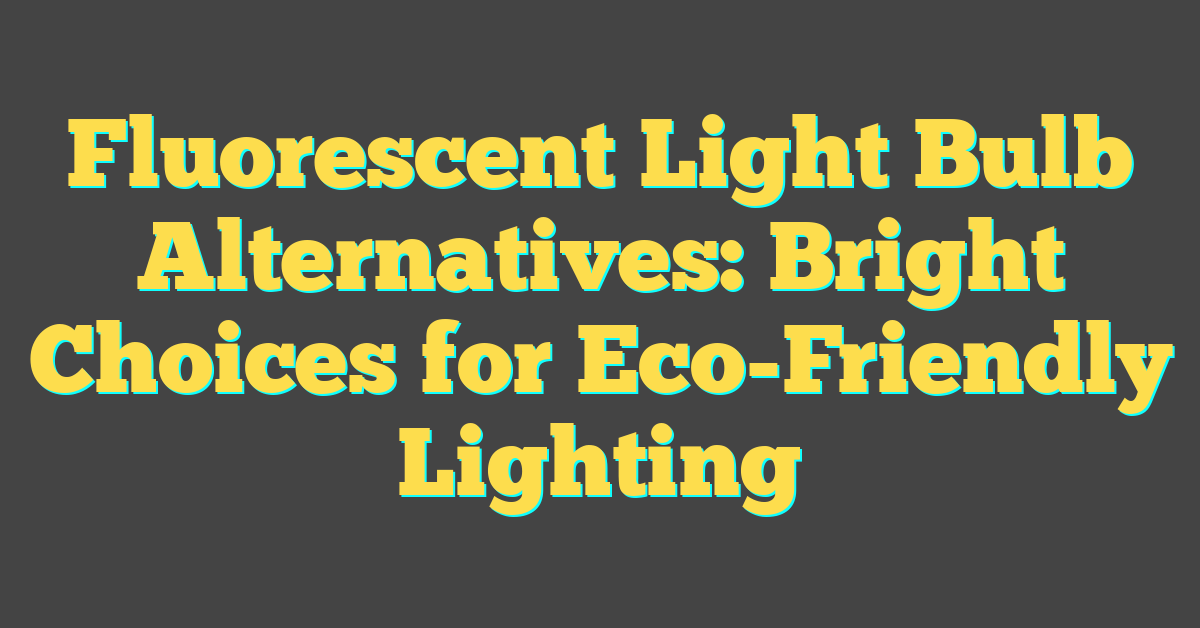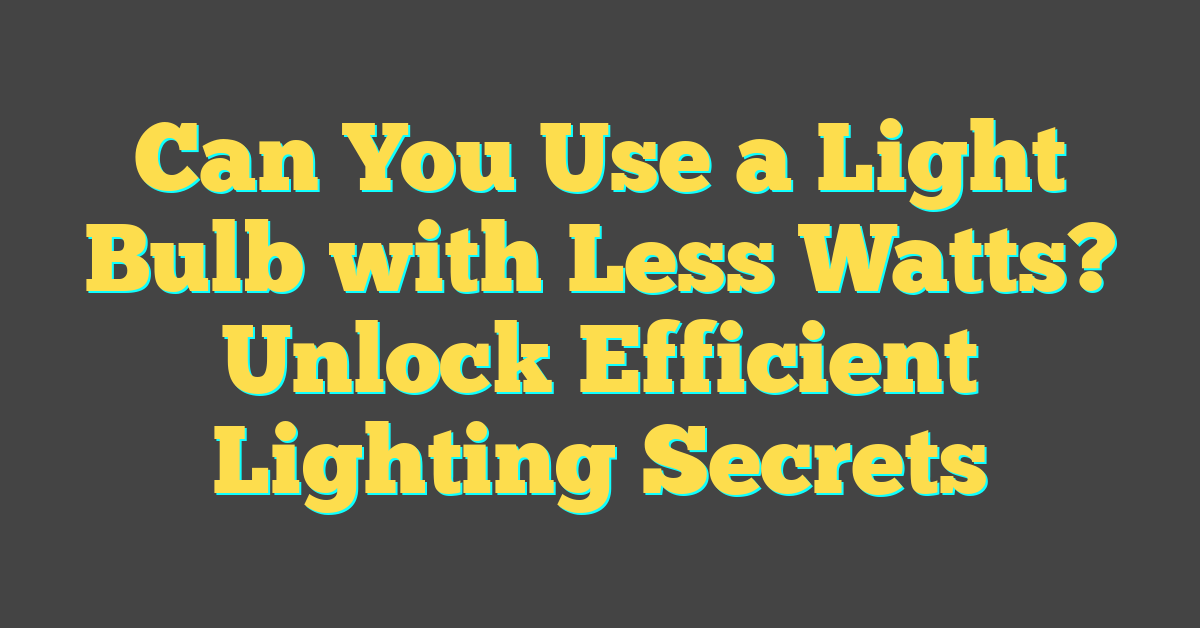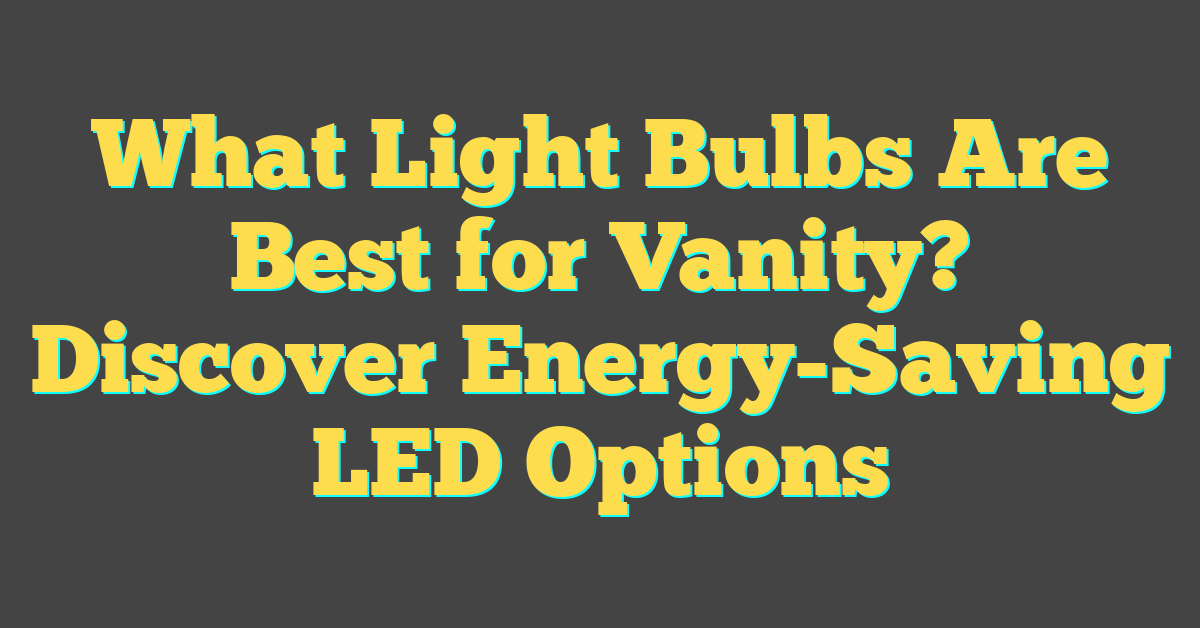As lighting technology evolves, many people are seeking fluorescent light bulb alternatives for their homes and workplaces. Fluorescent lights, though historically popular for their energy efficiency, have some drawbacks including the presence of mercury, a harsh light quality, and flickering issues. Alternatives to these lights can offer improved energy efficiency, better light quality, and are often more environmentally friendly. Among the top choices are LED bulbs and tubes, which not only consume less electricity but also have a longer lifespan, reducing the need for frequent replacements.


When considering a shift from traditional fluorescent bulbs, there are several factors to evaluate. It is essential to understand the basics of different lighting technologies, assess your specific lighting needs, and compare the various options available. LED technology, for example, can be tailored for smart home systems and may provide a healthier and more natural indoor lighting environment. Moreover, by opting for such energy-efficient alternatives, you are likely to see a decrease in your electricity bills while also contributing to a lower environmental footprint.
Key Takeaways
- LED options offer longer life and lower energy consumption compared to fluorescent bulbs.
- Assessing lighting needs can guide the choice for a suitable fluorescent bulb replacement.
- Transitioning to energy-efficient lighting can provide both financial benefits and environmental advantages.
Basics of Fluorescent Lighting

Fluorescent lighting has been a staple in both residential and commercial settings for many years. Understanding its fundamental components and the role of mercury is essential in grasping how these lights work.
Fluorescent Tubes and Their Components
Your typical fluorescent tube is a low-pressure mercury-vapor gas-discharge lamp that converts electrical energy into usable light. They consist of several key parts: a glass tube, electrodes at each end, and a mixture of gases like argon and mercury vapor. The inner surface of the tube is coated with a phosphorescent material which emits light when excited.
The components work together in a sequence:
When you switch the light on, electricity flows through the electrodes.
This electrical current excites the mercury vapor, generating ultraviolet (UV) light.
The UV light then causes the phosphorescent coating to “fluoresce” or light up, producing the visible light you see.
The Role of Mercury in Fluorescent Lights
Mercury is a crucial element in fluorescent tubes. Even though it’s toxic, the amount present in a fluorescent tube is very small. Here’s what mercury does:
UV Light Production: Mercury atoms get charged up (excited) when electricity is applied, emitting UV light.
Energy Efficiency: The UV light interacts with the phosphor coating to emit visible light, making fluorescent tubes much more energy-efficient compared to other light sources like incandescent bulbs.
Always handle fluorescent lights with care to prevent mercury exposure, and dispose of burnt-out tubes properly, according to local regulations to minimize environmental impact.
Introduction to LED Technology
https://www.youtube.com/watch?v=vDYZxWNDm4k&embed=true
As you consider alternatives to fluorescent light bulbs, it’s crucial to understand LED technology, which stands for light emitting diode. It’s a highly efficient lighting option that’s gained popularity due to its energy savings and long lifespan.
Advantages of LED Bulbs
LED bulbs are a smart choice for both residential and commercial lighting needs. Here’s why:
- Energy Efficiency: LEDs consume significantly less power than traditional fluorescent lights. This translates to lower energy bills and a reduced carbon footprint.
- Longevity: On average, an LED bulb lasts about 25,000 hours, which far surpasses the lifespan of a standard fluorescent bulb.
- Durability: LEDs are more resistant to breakage as they are made with sturdy semiconductor material, which is less fragile than the glass used in fluorescents.
- Versatility: You’ll find LED bulbs suitable for a wide range of applications, from indoor to outdoor settings, available in various colors and brightness levels.
LEDs vs Fluorescent: Understanding the Technology
Understanding the difference between LED and fluorescent technology can help you make an informed decision:
- Illumination Method: While fluorescent bulbs use a chemical reaction involving mercury vapor to produce light, LEDs use a semiconductor that emits light when an electric current passes through it.
- Mercury-Free: Unlike fluorescents, LED lighting does not contain mercury, making them safer and easier to dispose of or recycle.
- Instant Lighting: LEDs reach full brightness instantly, without the flickering or warm-up time associated with some fluorescent tubes.
- Heat Emission: LED bulbs emit far less heat compared to fluorescent bulbs, contributing to a cooler environment and reducing cooling costs.
By understanding these key aspects of LED technology, you can appreciate the benefits they offer over traditional fluorescent lighting.
Evaluating Lighting Needs
https://www.youtube.com/watch?v=mmR5iEEP9q8&embed=true
« Energy Efficient Light Bulbs Pros and Cons: A Balanced Guide
LED Light Bulbs Comparison Charts: Find Your Perfect Illumination Match »
When it comes to choosing lighting alternatives to fluorescent bulbs, you need to consider the specific requirements of your space. This includes determining whether you need indoor or outdoor lighting, and understanding the importance of lumens and color temperature to achieve the desired brightness and ambiance.
Indoor vs Outdoor Lighting
Indoor lighting needs vary greatly depending on the room and its purpose. For areas like home offices or kitchens, you may require bright, task-oriented lighting. In contrast, living areas or bedrooms may benefit from softer, ambient lighting. When replacing fluorescent lights indoors, options such as LED bulbs and tubes can match the output while providing a better quality of light.
For outdoor lighting, durability and water resistance are key. Outdoor spaces often require brighter lights for security or visibility, which means higher lumens. LED technology is also prevalent here, as it can withstand temperature variations and moisture while providing substantial energy savings.
Assessing Brightness and Color Temperature
Brightness in light bulbs is measured in lumens. The higher the lumens, the brighter the light. To replace a standard fluorescent tube that emits about 2,500 lumens, you’d need an LED alternative that offers the same level of brightness.
Color temperature is just as important as brightness. Measured in Kelvin (K), color temperature influences the feel of the light emitted. Lower Kelvin numbers mean warmer, yellowish light, while higher numbers result in cooler, bluish light—similar to natural lighting. For a cozy indoor atmosphere, look for bulbs with a color temperature around 2700K, while for outdoor security lights or task lighting, choose options nearing 5000K for a more alert and focused environment.
Comparing Light Bulb Alternatives
https://www.youtube.com/watch?v=I9BuIM0bAgw&embed=true
When choosing between light bulb options for your space, it’s essential to consider factors such as energy efficiency and the quality of light they provide. Below is a detailed comparison to help you make an informed decision.
LED Tubes vs Fluorescent Tubes
LED tubes are becoming a popular replacement for traditional fluorescent tubes due to their energy-saving qualities. While fluorescent tubes are known for their bright and widespread light, they contain mercury, which requires careful disposal. LED tubes, on the other hand, last longer and can save up to 40% on your energy bill. They also turn on instantly and do not emit UV light.
- Fluorescent Tubes: Inexpensive, bright light, contains mercury.
- LED Tubes: Energy efficient, long lifespan, mercury-free.
CFLs and Halogen Bulbs as Alternatives
Compact Fluorescent Lamps (CFLs) offer a balance between energy efficiency and cost. They use about 70% less energy than incandescent bulbs but take a moment to reach full brightness. On the durability front, they generally last longer than incandescent but not as long as LED options.
Halogen bulbs are more efficient than traditional incandescent bulbs and operate at higher temperatures. Their light is more intense and they reach full brightness without delay. However, they are less energy efficient than CFLs or LEDs and have a shorter lifespan.
- CFLs: Cost-effective, energy saver, slower start-up.
- Halogen Bulbs: Bright light, instant on, less efficient.
Energy Efficiency and Cost Savings
https://www.youtube.com/watch?v=TzDA-paae3k&embed=true
Making the switch to more energy-efficient lighting options, such as LEDs, can offer significant cost savings on your utility and electricity bills due to reduced energy consumption.
Reducing Electricity Bills
Did you know that lighting can account for up to 15% of your home’s electricity usage? By choosing LED lighting, you could save around $225 annually on your energy costs. LEDs are not only up to 44% more energy-efficient than traditional fluorescent tubes but also significantly decrease your electricity bills.
Understanding Lifespan and Maintenance Costs
When you’re comparing lighting options, it’s crucial to consider both the lifespan of the bulb and the associated maintenance costs. LEDs outshine their counterparts by offering an impressive lifespan which means you’ll replace them far less frequently. This longevity not only reduces the waste associated with burnt-out bulbs but also cuts down on the cumulative costs of maintenance and replacement over time. The University of Michigan study confirms that upgrading to LEDs from fluorescents can be a financially savvy move for the long haul.
Health and Environmental Benefits
https://www.youtube.com/watch?v=nCrgCLTxRaI&embed=true
When you switch to energy-efficient lighting alternatives, you’re not just saving on your electricity bill – you’re also contributing to a healthier environment and reducing potential health concerns associated with traditional fluorescent light bulbs.
Safety and Health Concerns
Traditional fluorescent bulbs contain a small amount of mercury, posing a hazard if the bulbs are broken. Your safety can be improved with LED light bulbs, as they contain no hazardous substances and offer a lower risk of health issues. In terms of maintenance, LEDs also last longer, which means you’re exposed to fewer risks associated with changing bulbs.
Environmental Impact of Light Bulbs
Switching to LED lighting is a significant stride towards a more sustainable future. These bulbs are over 80% more energy efficient than conventional fluorescents and have a much longer lifespan. With less frequent replacement and lower energy consumption, you contribute to reducing waste and resource use. The environmental benefits are clear as LEDs help lower carbon emissions, supporting global efforts like the efforts to phase out fluorescent lighting by 2025 according to the Clean Lighting Coalition.
Smart Lighting Options
https://www.youtube.com/watch?v=4o8PPpSN23Y&embed=true
Transitioning to modern lighting solutions not only allows for energy efficiency but also offers a realm of customizable features. Smart lighting options in particular give you control over the ambiance of your space and integrate smoothly with your tech-savvy lifestyle.
Integrating with Smart Home Hubs
When it comes to integrating smart bulbs into your home, compatibility with smart home hubs like Google Assistant and Amazon Alexa should be your top priority. These platforms enable you to manage your lighting through voice commands or a centralized app. For hands-free operation, ensure your choice of smart lighting can seamlessly connect to these powerful tools. Products like the Philips Hue White and Color Ambiance A19 Starter Kit are praised for their easy integration with various home automation systems.
The Flexibility of Dimmable and Colored Lights
If you’re keen on setting the right mood or need different lighting for various activities, opting for dimmable and colored lamps can be a transformative decision. Smart bulbs often come with a spectrum of colors and adjustable brightness levels. This feature enables you to dim the lights for a cozy movie night or brighten the room for your morning routine. Moreover, gadgets like the Nanoleaf Shapes can add a creative touch to any room, offering both customizable colors and design flexibility.
Lighting Innovations and Retrofits
https://www.youtube.com/watch?v=vybWYKetJyM&embed=true
When exploring lighting options, retrofitting your existing fixtures can offer a significant upgrade in energy efficiency and performance. In particular, specialized solutions like high bay and low bay lighting have evolved to fit various industrial and commercial spaces.
Retrofitting Existing Fixtures
Retrofitting your current lighting fixtures is a cost-effective way to enhance lighting quality and reduce energy consumption. You can often convert traditional fluorescent fixtures to LED by changing the lamps or modifying the existing fixture. By undertaking a LED conversion retrofit, you not only decrease your energy expenses but also extend the lifespan of your lighting system, as LEDs typically last longer than fluorescent tubes. Additionally, this process often qualifies for energy rebates, further offsetting the initial costs.
- Benefits of Retrofitting:
- Enhanced light quality
- Decreased energy usage
- Lower maintenance costs
- Potential for rebates
High Bay and Low Bay Lighting Solutions
For spaces with higher ceilings, high bay lighting is an ideal choice, as it is designed to illuminate areas from heights greater than 20 feet. Conversely, low bay lighting fits well in spaces with ceilings up to 20 feet high. These lighting types are specifically tailored to provide the right amount of brightness and dispersion based on ceiling height.
Upgrades in high bay and low bay fixtures have brought about LEDs that are not only more energy-efficient but also provide a better quality of light. The use of mirrors and lenses in these fixtures enhances light distribution and diminishes glare, creating a more comfortable environment.
- Selecting the Right Solution:
- For ceilings over 20 feet, consider high bay LED solutions.
- For ceilings 20 feet and below, low bay LED fixtures are your best bet.
- Evaluate lumens per watt (efficiency) and color temperature (light appearance).
By focusing on retrofitting and specialized lighting solutions like high bay and low bay LEDs, you can achieve an optimal balance between performance and efficiency in your lighting system.
Lighting for Specific Needs

When you’re tailoring lighting solutions for specific areas of your home or office, it’s important to consider the unique requirements of each space. Whether you’re nurturing indoor plants or seeking the best way to harness natural light, selecting the right type of lighting is crucial.
Growing Plants with LED Lights
For your indoor garden, LED lights are an excellent choice. They provide the full spectrum of light that plants require to photosynthesize properly, without the heat and energy consumption of traditional grow lights. With LED lights designed for plants, you can expect your greens to thrive. Remember to place your lights close to the plants—within a couple of feet—to ensure they receive ample light.
- Advantages:
- Low heat emission
- Energy efficient
- Long lifespan
Natural Light Sources and Control Systems
Maximizing natural light in your space through windows and skylights can enhance mood and save on energy costs. However, to avoid overillumination or glare, consider installing lighting controls like dimmers or timers. These systems allow you to adjust the indoor lighting levels in harmony with the natural light available, providing comfort and efficiency.
- Considerations:
- Direction your windows face (south-facing allows more winter sun)
- Use of curtains or blinds for diffusing light
- Automated systems for optimal light throughout the day
By integrating LED lights for your plants and smart controls for your natural lighting sources, you’re creating a balanced and responsive environment catered to your specific needs.
Moving Beyond Traditional Bulbs
https://www.youtube.com/watch?v=m_tH_g9KXHY&embed=true
As you consider upgrading your home lighting, you’ll discover an array of energy-efficient and technologically advanced options that surpass traditional bulbs both in longevity and performance.
Exploring Alternative Lighting Methods
Switching from traditional fluorescent light tubes to compact fluorescent bulbs (CFLs) can be a straightforward first step. These bulbs fit into your existing light fixtures easily and leverage fluorescent technology in a more compact form.
However, if you’re aiming for increased energy savings and longer lifespan, LED light bulbs are a top choice. LEDs use significantly less energy and can last many times longer than traditional bulbs. In fact, replacing a 52-Watt fluorescent tube with a 25-Watt LED can cut your energy usage by over half, not to mention the benefits of no longer needing a ballast and improved lighting control options which are detailed in guides about replacing fluorescent lights.
The Future of Lighting: From Ceramics to Smart Controls
Future lighting technologies are not just about saving energy; they also offer enhanced functionality. Imagine integrating your lighting with a smart home hub, allowing you to optimize your energy usage and control settings from anywhere with ease. LED panel lights exemplify modern lighting solutions that blend seamlessly into ceilings or walls, creating a sleek look with uniform illumination.
Moreover, advancements in materials like ceramics are contributing to the next wave of energy-efficient light sources. These innovative ceramic LEDs are more resistant to temperature changes and heat, ensuring a longer lifespan and consistent light quality.
Your journey towards an enlightened, energy-efficient home is not just about adopting new lighting but also embracing smarter living.
Practical Tips for Transition
https://www.youtube.com/watch?v=X–Dm-Qsggw&embed=true
Transitioning from traditional lighting to more energy-efficient options can be both eco-friendly and cost-effective. Here are some practical steps you can take to navigate this change smoothly.
Navigating the Ban on Incandescent Bulbs
With the ban on incandescent light bulbs, you’re likely looking for sustainable and long-lasting alternatives. LEDs are the front-runners in energy efficiency. When shopping, look for LED tube lighting, which offers a direct replacement for fluorescent tubes. This switch not only aligns with environmental regulations but also contributes to a significant reduction in your energy bills.
Shopping for Budget-friendly LED Options
To ensure you’re choosing budget-friendly LED options, consider the initial purchase price against the long-term savings on your energy bills. LED lighting comes with a higher upfront cost but translates to savings over time due to their low energy consumption and longer lifespan. To start, explore LED conversion management solutions that retrofit existing fixtures to accommodate LED bulbs effortlessly, saving you the cost of a complete overhaul.




